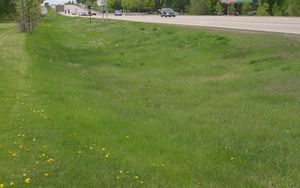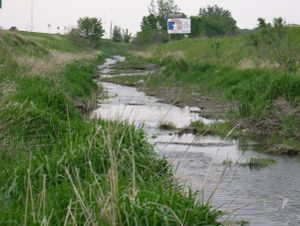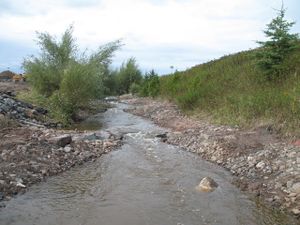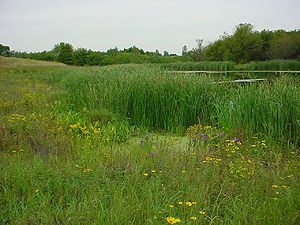
Difference between revisions of "Green Infrastructure benefits of vegetated swales"
(Created page with "In development") |
m |
||
| Line 1: | Line 1: | ||
| − | In | + | [[File:Pdf image.png|100px|thumb|right|alt=pdf image|<font size=3>[ Download pdf]</font size>]] |
| + | [[File:General information page image.png|right|100px|alt=image]] | ||
| + | [[File:Dry swale.jpg|300 px|thumb|alt=photo of a dry swale|<font size=3>Photo of a dry swale. Courtesy of Limnotech.</font size>]] | ||
| + | [[File:Wet swale.jpg|300 px|thumb|alt=photo of a wet swale|<font size=3>Photo of a wet swale. Courtesy of Limnotech.</font size>]] | ||
| + | [[File:Step pool.jpg|300px|thumb|alt=image of step pool|<font size=3>Stormwater step pool. Courtesy of Limnotech.</font size>]] | ||
| + | |||
| + | Dry swales, sometimes called grass swales, are similar to bioretention cells but are configured as shallow, linear channels. They typically have vegetative cover such as turf or native perennial grasses. Dry swales may be constructed as filtration or infiltration practices, depending on soils. If soils are highly permeable (A or B soils), runoff infiltrates into underlying soils. In less permeable soils, runoff is treated by engineered soil media and flows into an underdrain, which conveys treated runoff back to the conveyance system further downstream. Check dams incorporated into the swale design allow water to pool up and infiltrate into the underlying soil or engineered media, thus increasing the volume of water treated. | ||
| + | |||
| + | Wet swales occur when the water table is located very close to the surface or water does not readily drain out of the swale. A wet swale acts as a very long and linear shallow [https://stormwater.pca.state.mn.us/index.php?title=Bioretention_terminology#General_discussion_of_types_of_bioretention_BMPs biofiltration] or [https://stormwater.pca.state.mn.us/index.php?title=Stormwater_wetlands linear wetland treatment system]. Wet swales do not provide volume reduction and have limited treatment capability. Incorporation of check dams into the design allows treatment of a portion or all of the [https://stormwater.pca.state.mn.us/index.php?title=Water_quality_criteria water quality volume] within a series of cells created by the check dams. Wet swales planted with [https://stormwater.pca.state.mn.us/index.php?title=Plants_for_swales emergent wetland plant species] provide improved pollutant removal. Wet swales may be used as [[Pretreatment|pretreatment]] practices. Wet swales are commonly used for drainage areas less than 5 acres in size. | ||
| + | |||
| + | Stormwater step pools are defined by its design features that address higher energy flows due to more dramatic slopes than dry or wet swales. Using a series of pools, riffle grade control, native vegetation and a sand seepage filter bed, flow velocities are reduced, treated, and, where applicable, infiltrated. to shallow groundwater. The physical characteristics of the stormwater step pools are similar to Rosgen A or B stream classification types, where “bedform occurs as a step/pool, cascading channel which often stores large amounts of sediment in the pools associated with debris dams” (Rosgen, 1996). These structures feature surface/subsurface runoff storage seams and an energy dissipation design that is aimed at attenuating the flow to a desired level through energy and hydraulic power equivalency principles (Anne Arundel County, 2009). Stormwater step pools are designed with a wide variety of native plant species depending on the hydraulic conditions and expected post-flow soil moisture at any given point within the stormwater step pool. | ||
| + | |||
| + | ==Green infrastructure and multiple benefits== | ||
| + | <span title="Green stormwater infrastructure is designed to mimic nature and capture rainwater where it falls. Green infrastructure reduces and treats stormwater at its source while while also providing multiple community benefits such as improvements in water quality, reduced flooding, habitat, carbon capture, etc."> '''Green infrastructure'''</span> (GI) encompasses a wide array of practices, including stormwater management. <span title="Green stormwater infrastructure (GSI) describes practices that use natural systems (or engineered systems that mimic or use natural processes) to capture, clean, and infiltrate stormwater; shade and cool surfaces and buildings; reduce flooding, create wildlife habitat; and provide other services that improve environmental quality and communities’ quality of life. (City of Tucson)"> '''Green stormwater infrastructure'''</span> (GSI) encompasses a variety of practices primarily designed for managing stormwater runoff but that provide additional benefits such as habitat or aesthetic value. | ||
| + | |||
| + | There is no universal definition of GI or GSI ([https://www.interreg-central.eu/Content.Node/Definitions.html link here fore more information]). Consequently, the terms are often interchanged, leading to confusion and misinterpretation. GSI practices are designed to function as stormwater practices first (e.g. flood control, treatment of runoff, volume control), but they can provide additional benefits. Though designed for stormwater function, GSI practices, where appropriate, should be designed to deliver multiple benefits (often termed "multiple stacked benefits". For more information on green infrastructure, ecosystem services, and sustainability, link to [[Multiple benefits of green infrastructure and role of green infrastructure in sustainability and ecosystem services]]. | ||
| + | |||
| + | {| class="wikitable" style="float:right; margin-left: 10px; width:500px;" | ||
| + | |- | ||
| + | ! Benefit !! Effectiveness !! Notes | ||
| + | |- | ||
| + | | Water quality || <font size=4><center>◕</center></font size> || Primary benefit is retention of sediment and associated pollutants; nutrient cycling in properly functioning wetlands; may export phosphorus if not designed and maintained properly. | ||
| + | |- | ||
| + | | Water quantity/supply || <font size=4><center>◔</center></font size> || Rate control, flooding benefit. | ||
| + | |- | ||
| + | | Energy savings || <font size=4><center>◔</center></font size> || | ||
| + | |- | ||
| + | | Climate resiliency || <font size=4><center>◔</center></font size> || Provides some rate control. Impacts on carbon sequestration are uncertain. | ||
| + | |- | ||
| + | | Air quality || <font size=4><center>◔</center></font size> || | ||
| + | |- | ||
| + | | Habitat improvement || <font size=6><center>◕</center></font size> || Use of perennial vegetation and certain media mixes promote invertebrate communities. | ||
| + | |- | ||
| + | | Community livability || <font size=4><center>◑</center></font size> || Aesthetically pleasing and can be incorporated into a wide range of land use settings. | ||
| + | |- | ||
| + | | Health benefits || <font size=4><center>◔</center></font size> || | ||
| + | |- | ||
| + | | Economic savings || <font size=4><center>◔</center></font size> || Generally provide cost savings vs. conventional practices over the life of the practice. | ||
| + | |- | ||
| + | |Macroscale benefits || <font size=4><center>◔</center></font size> || Individual practices are typically microscale, but multiple practices, when incorporated into a landscape design, provide macroscale benefits such as wildlife corridors. | ||
| + | |- | ||
| + | | colspan="3" | Level of benefit: ◯ - none; <font size=5>◔</font size> - small; <font size=5>◑</font size> - moderate; <font size=5>◕</font size> - large; <font size=6>●</font size> - very high | ||
| + | |} | ||
| + | |||
| + | ==Green Infrastructure benefits of vegetated swales== | ||
| + | *[https://stormwater.pca.state.mn.us/index.php?title=Water_quality_benefits_of_Green_Stormwater_Infrastructure '''Water quality''']: | ||
| + | *[https://stormwater.pca.state.mn.us/index.php?title=Water_quantity_and_hydrology_benefits_of_Green_Stormwater_Infrastructure '''Water quantity and hydrology''']: | ||
| + | *'''Energy''': | ||
| + | *[https://stormwater.pca.state.mn.us/index.php?title=Climate_benefits_of_Green_Stormwater_Infrastructure '''Climate resiliency''']: | ||
| + | *[https://stormwater.pca.state.mn.us/index.php?title=Air_quality_benefits_of_Green_Stormwater_Infrastructure '''Air quality''']: benefits are largely indirect, such as carbon sequestration; potential concerns with improperly maintained wetlands releasing methane. | ||
| + | *[https://stormwater.pca.state.mn.us/index.php?title=Wildlife_habitat_and_biodiversity_benefits_of_Green_Stormwater_Infrastructure '''Habitat improvement''']: | ||
| + | *[https://stormwater.pca.state.mn.us/index.php?title=Social_benefits_of_Green_Stormwater_Infrastructure '''Community livability''']: | ||
| + | *[https://stormwater.pca.state.mn.us/index.php?title=Social_benefits_of_Green_Stormwater_Infrastructure '''Health benefits''']: | ||
| + | *[https://stormwater.pca.state.mn.us/index.php?title=Economic_benefits_of_Green_Stormwater_Infrastructure '''Economic benefits and savings''']: | ||
| + | *'''Macroscale benefits''': | ||
| + | |||
| + | ==Design considerations for vegetated swales== | ||
| + | [[File: Photo 2 of stormwater wetland.jpg|right|thumb|300 px|alt=This photo shows a an example of a stormwater wetland|<font size=3>Example of a stormwater wetland in a largely undeveloped area. Constructed wetlands in developing areas offer potential to incorporate many of the design features discussed in this section.</font size>]] | ||
| + | |||
| + | Maximizing specific green infrastructure (GI) benefits of constructed ponds requires design considerations prior to constructing the practice. While site limitations cannot always be overcome, the following recommendations maximize the GI benefit of constructed ponds. | ||
| + | *Water quality ([https://lcau.mit.edu/sites/lcau.mit.edu/files/attachments/project/Design%20Guidelines_Web%20Version.pdf Balderas-Guzman et al., 2018]) | ||
| + | *Water quantity/supply | ||
| + | *Climate resiliency | ||
| + | *Habitat | ||
| + | *Community livability | ||
| + | *Health benefits | ||
| + | *Economic benefits ([https://www.nachi.org/constructedwetlands.htm Constructed Wetlands: The Economic Benefits of Runoff Controls National Association of Certified Home Inspectors]) | ||
| + | |||
| + | ==Recommended reading== | ||
| + | |||
| + | ==References== | ||
| + | |||
| + | ==Stormwater swales portals in the Minnesota Stormwater Manual== | ||
| + | *[[Dry swale (Grass swale)]] | ||
| + | *[[Wet swale (wetland channel)]] | ||
| + | *[[High-gradient stormwater step-pool swale]] | ||
Revision as of 18:44, 12 October 2022
Dry swales, sometimes called grass swales, are similar to bioretention cells but are configured as shallow, linear channels. They typically have vegetative cover such as turf or native perennial grasses. Dry swales may be constructed as filtration or infiltration practices, depending on soils. If soils are highly permeable (A or B soils), runoff infiltrates into underlying soils. In less permeable soils, runoff is treated by engineered soil media and flows into an underdrain, which conveys treated runoff back to the conveyance system further downstream. Check dams incorporated into the swale design allow water to pool up and infiltrate into the underlying soil or engineered media, thus increasing the volume of water treated.
Wet swales occur when the water table is located very close to the surface or water does not readily drain out of the swale. A wet swale acts as a very long and linear shallow biofiltration or linear wetland treatment system. Wet swales do not provide volume reduction and have limited treatment capability. Incorporation of check dams into the design allows treatment of a portion or all of the water quality volume within a series of cells created by the check dams. Wet swales planted with emergent wetland plant species provide improved pollutant removal. Wet swales may be used as pretreatment practices. Wet swales are commonly used for drainage areas less than 5 acres in size.
Stormwater step pools are defined by its design features that address higher energy flows due to more dramatic slopes than dry or wet swales. Using a series of pools, riffle grade control, native vegetation and a sand seepage filter bed, flow velocities are reduced, treated, and, where applicable, infiltrated. to shallow groundwater. The physical characteristics of the stormwater step pools are similar to Rosgen A or B stream classification types, where “bedform occurs as a step/pool, cascading channel which often stores large amounts of sediment in the pools associated with debris dams” (Rosgen, 1996). These structures feature surface/subsurface runoff storage seams and an energy dissipation design that is aimed at attenuating the flow to a desired level through energy and hydraulic power equivalency principles (Anne Arundel County, 2009). Stormwater step pools are designed with a wide variety of native plant species depending on the hydraulic conditions and expected post-flow soil moisture at any given point within the stormwater step pool.
Contents
Green infrastructure and multiple benefits
Green infrastructure (GI) encompasses a wide array of practices, including stormwater management. Green stormwater infrastructure (GSI) encompasses a variety of practices primarily designed for managing stormwater runoff but that provide additional benefits such as habitat or aesthetic value.
There is no universal definition of GI or GSI (link here fore more information). Consequently, the terms are often interchanged, leading to confusion and misinterpretation. GSI practices are designed to function as stormwater practices first (e.g. flood control, treatment of runoff, volume control), but they can provide additional benefits. Though designed for stormwater function, GSI practices, where appropriate, should be designed to deliver multiple benefits (often termed "multiple stacked benefits". For more information on green infrastructure, ecosystem services, and sustainability, link to Multiple benefits of green infrastructure and role of green infrastructure in sustainability and ecosystem services.
| Benefit | Effectiveness | Notes |
|---|---|---|
| Water quality | Primary benefit is retention of sediment and associated pollutants; nutrient cycling in properly functioning wetlands; may export phosphorus if not designed and maintained properly. | |
| Water quantity/supply | Rate control, flooding benefit. | |
| Energy savings | ||
| Climate resiliency | Provides some rate control. Impacts on carbon sequestration are uncertain. | |
| Air quality | ||
| Habitat improvement | Use of perennial vegetation and certain media mixes promote invertebrate communities. | |
| Community livability | Aesthetically pleasing and can be incorporated into a wide range of land use settings. | |
| Health benefits | ||
| Economic savings | Generally provide cost savings vs. conventional practices over the life of the practice. | |
| Macroscale benefits | Individual practices are typically microscale, but multiple practices, when incorporated into a landscape design, provide macroscale benefits such as wildlife corridors. | |
| Level of benefit: ◯ - none; ◔ - small; ◑ - moderate; ◕ - large; ● - very high | ||
Green Infrastructure benefits of vegetated swales
- Water quality:
- Water quantity and hydrology:
- Energy:
- Climate resiliency:
- Air quality: benefits are largely indirect, such as carbon sequestration; potential concerns with improperly maintained wetlands releasing methane.
- Habitat improvement:
- Community livability:
- Health benefits:
- Economic benefits and savings:
- Macroscale benefits:
Design considerations for vegetated swales
Maximizing specific green infrastructure (GI) benefits of constructed ponds requires design considerations prior to constructing the practice. While site limitations cannot always be overcome, the following recommendations maximize the GI benefit of constructed ponds.
- Water quality (Balderas-Guzman et al., 2018)
- Water quantity/supply
- Climate resiliency
- Habitat
- Community livability
- Health benefits
- Economic benefits (Constructed Wetlands: The Economic Benefits of Runoff Controls National Association of Certified Home Inspectors)





